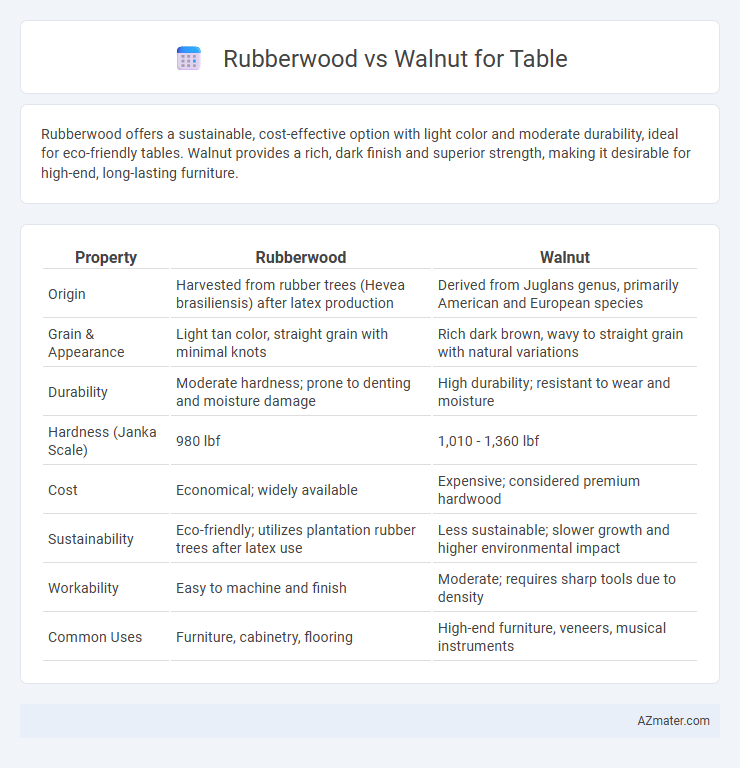Rubberwood offers a sustainable, cost-effective option with light color and moderate durability, ideal for eco-friendly tables. Walnut provides a rich, dark finish and superior strength, making it desirable for high-end, long-lasting furniture.
Table of Comparison
| Property | Rubberwood | Walnut |
|---|---|---|
| Origin | Harvested from rubber trees (Hevea brasiliensis) after latex production | Derived from Juglans genus, primarily American and European species |
| Grain & Appearance | Light tan color, straight grain with minimal knots | Rich dark brown, wavy to straight grain with natural variations |
| Durability | Moderate hardness; prone to denting and moisture damage | High durability; resistant to wear and moisture |
| Hardness (Janka Scale) | 980 lbf | 1,010 - 1,360 lbf |
| Cost | Economical; widely available | Expensive; considered premium hardwood |
| Sustainability | Eco-friendly; utilizes plantation rubber trees after latex use | Less sustainable; slower growth and higher environmental impact |
| Workability | Easy to machine and finish | Moderate; requires sharp tools due to density |
| Common Uses | Furniture, cabinetry, flooring | High-end furniture, veneers, musical instruments |
Introduction: Rubberwood vs Walnut for Tables
Rubberwood and walnut are popular choices for table construction, each offering distinct characteristics in durability and aesthetics. Rubberwood, derived from parawood trees, is valued for its cost-effectiveness and sustainable sourcing, featuring a light, uniform grain ideal for modern furniture. Walnut, a premium hardwood, excels in rich color variation and strength, making it a favored option for high-end, long-lasting tables.
Origin and Source of Rubberwood and Walnut
Rubberwood originates primarily from the latex-producing Hevea brasiliensis tree, cultivated extensively in Southeast Asia, especially Malaysia and Thailand, where former rubber plantations are repurposed for timber. Walnut, predominantly sourced from Juglans species native to North America and parts of Europe, is prized for its rich, dark heartwood and fine grain. The sustainable supply of rubberwood stems from recycling rubber trees after their latex production declines, while walnut lumber is typically harvested from mature forests with regulated forestry practices.
Appearance and Color Comparison
Rubberwood features a pale, creamy color with subtle grain patterns, offering a light and uniform appearance ideal for contemporary table designs. Walnut presents a rich, dark brown hue with deep, pronounced grains that add warmth and classic elegance to furniture surfaces. The distinct contrast in color intensity and grain complexity makes Rubberwood suitable for minimalist aesthetics, while Walnut enhances traditional or luxurious table styles.
Hardness and Durability
Rubberwood has a Janka hardness rating of approximately 980, making it moderately hard but less durable compared to walnut, which scores around 1010 to 1700 depending on the walnut species. Walnut is known for its superior strength and resistance to dents and scratches, providing better longevity for high-traffic table surfaces. While rubberwood is an eco-friendly, affordable option with decent durability, walnut's enhanced hardness ensures a more robust and lasting table investment.
Workability and Craftsmanship
Rubberwood offers excellent workability due to its uniform grain and moderate hardness, making it easier to cut, shape, and sand for intricate table designs. Walnut, with its dense, fine-grained texture, allows for precision craftsmanship and smooth finishes but requires sharper tools and more skill to avoid tear-out. Both woods provide durability, but rubberwood is preferred for cost-effective, efficient production, while walnut supports high-end, detailed artisan work in table making.
Environmental Impact and Sustainability
Rubberwood is a highly sustainable option for tables due to its origin from rubber trees that are no longer productive for latex, maximizing resource use and reducing deforestation. Walnut, while prized for its rich color and grain, often involves slower growth rates and less sustainable harvesting practices, leading to greater environmental impact. Choosing rubberwood supports eco-friendly furniture production by utilizing plantation wood that would otherwise be discarded, thereby lowering carbon footprint and promoting sustainable forestry.
Cost and Affordability
Rubberwood is significantly more affordable than walnut, making it an ideal choice for budget-conscious buyers seeking a durable table option. Walnut commands a higher price due to its rich color, grain patterns, and natural hardness, often preferred for luxury and high-end furniture. Rubberwood's cost-effectiveness combined with its eco-friendly appeal provides a practical alternative without compromising basic functionality.
Maintenance and Longevity
Rubberwood is a durable and cost-effective option for tables, requiring regular cleaning with a damp cloth and occasional oiling to maintain its finish and prevent drying or cracking. Walnut offers superior longevity with its dense hardwood structure, needing minimal maintenance besides dusting and periodic application of wood polish to preserve its rich color and grain. Both woods benefit from avoiding prolonged exposure to moisture and direct sunlight to maximize their lifespan and maintain aesthetic appeal.
Best Uses: Styles and Table Designs
Rubberwood is ideal for contemporary and casual table designs due to its light color and smooth grain, making it a popular choice for modern dining sets and rustic farmhouse styles. Walnut's rich, dark tones and pronounced grain patterns suit luxurious, traditional, and mid-century modern tables, adding warmth and elegance to executive desks and statement dining tables. Both woods perform well in sturdy, functional furniture, but walnut's durability and aesthetic depth make it favored for high-end, designer pieces.
Final Verdict: Rubberwood or Walnut for Your Table?
Rubberwood offers affordability, eco-friendliness, and medium durability, making it ideal for budget-conscious buyers and sustainable projects. Walnut provides superior strength, rich grain patterns, and long-lasting beauty, perfect for high-end, heirloom-quality tables. Choose Rubberwood for cost-effective, environmentally responsible options and Walnut for premium aesthetics and durability.

Infographic: Rubberwood vs Walnut for Table
 azmater.com
azmater.com